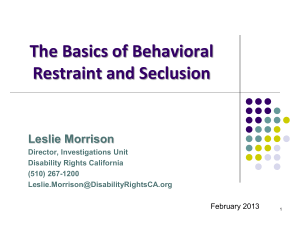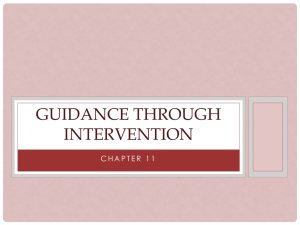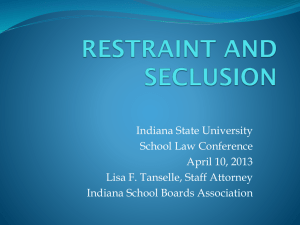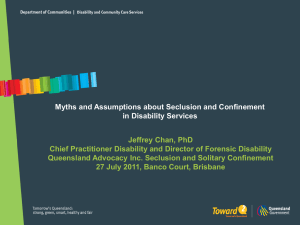Safer Services - Restraint Reduction Network
advertisement
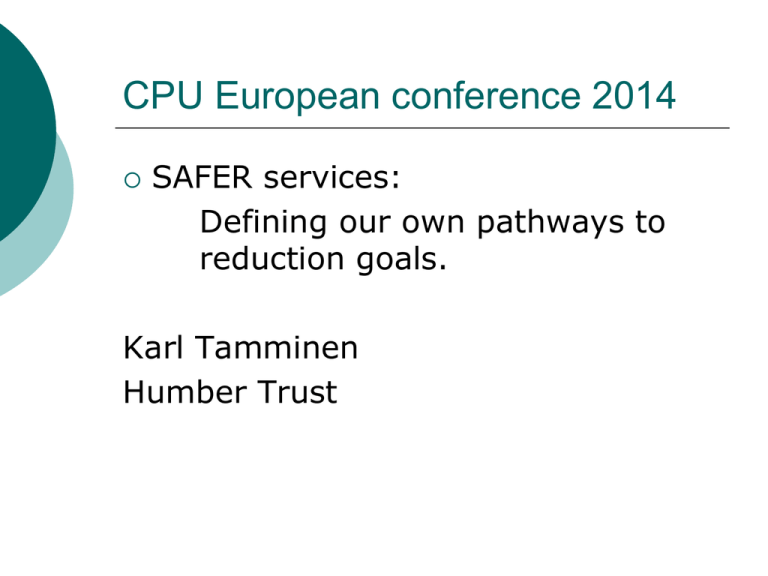
CPU European conference 2014 SAFER services: Defining our own pathways to reduction goals. Karl Tamminen Humber Trust Practice innovation. What is this presentation about? Dispelling a few myths. Challenging a few assumptions. Not about teaching people how “to suck eggs”, but discussing alternative perspectives. Ideas for changes in the ways service users and staff work together. A pathway to closer, more productive working relationships between service users and staff which serves to reduce engagement in restraint . ….But first a couple of questions…. Question 1: What do the following things have in common? What do the following have in common? Question 2: What do these people have in common? What do these people have in common? The quiz answers: What do they have in common? Answer one: These are all reasons people have been restrained, Answer two: These are all people who have tragically died, following restraint (initiated for the above reasons). Was that a surprise? Which are valid reasons to engage in restraint? What do these people have in common? Myth or true? Restraint and seclusion are never used as punishment. Restraint and seclusion are always used as a last resort. Restraint and seclusion are a valid treatment option. Restraint and seclusion are the main tools we have to maintain a safe environment. When we utilise restraint or seclusion we are always acting within the legislation. Professional practice is about developing and improving the way we use restraint and seclusion. There is no evidenced based alternative to restraint and seclusion who Age/ when where why outcome Adam Rickwood 14 (2004) Hassockfield Secure Training Centre in County Durham UK. Refused to move from the table he was sitting at with friends Psychological impact of restraint. Nose punch technique. Terrified child. Found dead by hanging in his bed space after resolution of restraint/ seclusion. Angelika Arndt 7. (2006) Children's Hospital in Minneapolis (US) Refused to stop gargling milk. Fell asleep in seclusion, restrained to ensure she “learned her lesson” Restraint as a consequence. Restraint to reinforce positive behaviour and disincentives negative complications from chest compression asphyxiation and said the restraint hold used by the staff at the centre may have contributed to her death. Gareth Myatt. 15 (2004) Rainsbrook Secure Training Centre (UK) Refused to clean out a toaster when directed by prison staff Positional asphyxia who Age/ when David (Rocky) Bennet 41 (1998) Jacob Michael 25 (2011) Faith Finlay Edith Campos where why outcome Altercation with fellow patient around phone use. Racist language used ." Mr Bennett's capacity to breathe was restricted and the restraint "continued for substantially longer than was safe". UK Called police for support, he refused to come out of his bedroom and threatened when police responded Up to eleven police personnel. Pronounced dead when taken into custody. Verdict misadventure 17 (2008) US Damaging her own property in her own room Prone restraint. Positional asphyxiation 15 (1998) US Refused to hand over family photograph (personal possessions against policy) Positional asphyxiation UK What are the facts in the British cases? The People Who Died: ● The people who died ranged in age from 9 to 95 years old. ● Nearly one-third of those who died were over the age of 65, with 14 seniors over the age of 80 at the time of their deaths. ● The four youngest children to die in restraints were 9 years old. ● Almost three-quarters of those who died were male. ● Nearly 75% of those who died had a psychiatric history, with the most common known diagnoses being schizophrenia, other psychotic disorders and mood disorders. ● More than half of those individuals admitted with a psychiatric diagnosis had been admitted for psychiatric treatment on three or more prior occasions. ● Twenty-five percent of those who died had a history of intellectual disabilities, learning disorders or other developmental disabilities. ● Nearly half of those who died had limited or no communication skills, due to medical circumstances that limited their awareness or consciousness. SOURCE: (NATIONAL REVIEW OF RESTRAINT RELATED DEATHS OF CHILDREN AND ADULTS WITH DISABILITIES: The Lethal Consequences of Restraint (2011)) The IAP reported that between the 1st January 1999 and the 31st December 2009, there were 6,151 deaths in state custody in all services. In 22 of these cases, restraint was involved Table 1 Deaths by age range setting No of restraint related deaths Age range 11-20 2130 prisons 1 0 1 0 0 0 0 0 Secure Young People’s 1 1 0 0 0 0 0 0 Immigration Removal Centres 0 0 0 0 0 0 0 0 Police 15 0 1 6 3 2 1 1 In-pt mental health setting 5 0 2 3 0 0 0 0 TOTAL 22 1 4 9 3 2 1 1 estates 3140 4150 5160 6170 7180 Why do we need to change? People die whilst being secluded and restrained. People are injured whilst being restrained and secluded. People suffer harmful psychological affects whilst being restrained and secluded. People have “flash backs” about restraint and seclusion. For the main part neither staff or service users like to engage in restraint or seclusion. Restraint and seclusion, as a measure of risk, can keep people in Mental Health services longer. I am here today to talk about the ingredients of a restraint and seclusion reduction programme. Restraint and seclusion is seen as a normal, expected and natural part of every day life within a mental health unit…do you think that is how it has to be? What is the current and predominant approach to restraint? 1. Have we trained people correctly to avoid injuries and to give people the tools to maintain a safe and effective working environment? 2.Do we have the paper work necessary for defensible practice? In short do we do it right and can we evidence it was done correctly? … That’s fine as far as it goes, but what we seldom ask is “why did we end up restraining in the first place?” Challenging the status quo? If the training and the paper work is “correct”… Is this a case of “its not broke so don’t fix it?” No. It cant be. People ask me the same question: “You know about restraint and seclusion Karl, got any tricks we could use to change the patients behaviour?” The answer? The “trick”, if there is one, is to change the question, its not about changing the way patients behave… …..Its about changing the way we behave. Is there another way? Yes… Who has written about “other” ways? Dr Bennington Davis and Dr Tim Murphy “pathway to restraint free services” (engagement and empowerment model) Dr Sandra Bloome “finding sanctuary (recovery focussed model) Ann Alty and Tom Mason “break with the past (1994) Joy Duxbury, Empowerment and engagement model is used in the Salem Hospital Oregon and the recovery focussed models are used across all the hospitals in Pennsylvania and Oregon. Salem hospitals: They attempted to reduce across both fronts The changing trend from 1994 Number of Seclusions by Year, 1994 through 9/2007 at Salem Hospital Psychiatry 400 368 350 309 301 291 287 300 250 222 Review ed data & recovery/ traum a m odel 1999-2000 200 Im plem ented m odel, 2001 150 96 100 53 50 10 3 1 0 0 0 2003 2004 2005 2006 2007 0 1994 1995 1996 1997 1998 1999 2000 2001 2002 The Salem Oregon project Total Annual Hours of Seclusion, 2000-9/2007 at Salem Hospital Psychiatry 1600 1450 1400 1200 1000 Hours 800 600 400 260.7 200 36.85 2.25 0.25 0 0 0 0 2000 2001 2002 2003 2004 Year 2005 2006 2007 Pennsylvania: across all hospitals and fronts: area one Area two: mechanical restraints Area three: physical restraint So where do we start? Owning change? Who needs to own it? Trust board? Clinicians? Service Users? Families and carers? In short…..We all need to own it and champion it in what ever way we can. If we don’t all make the process of change our own…then it will not happen. Identifying the layers of change Policy and procedure (embedding change) Daily rituals of practice Engagement of staff and service Users Approaches to restraint Avoiding inappropriate restraint Remaining empowered to restrain as a last resort measure Utilising data to inform practice Education and training Support and reflection Creating a learning, sharing system Pathway to restraint free services: what are the ingredients? Reclassify: restraint and seclusion are not treatment options they represent treatment failures and breakdowns Intensify: Scrutinise restraint. (use evidence and data to learn/ develop improve) feed that data into practice. Choices: Give staff alternatives and service users more meaningful choices. Pathway to restraint free services: what are the ingredients? Cont. Clinical focus: engage with Service Users and Care plan for a restraint and seclusion free therapeutic environment. Practice focus: examine the daily lives of our service Users, identify points of avoidable conflict and develop new ways of running wards Operational focus: directors and managers need to get behind the change, own it and support it. Reflect and relearn: Where it does happen, learn from it and plan try different approaches to avoid in the future. (restraint and seclusion reduction group) Break the mould: Dare to be different. Pathway to restraint free services: what are the ingredients? Cont. Reinvent: Be the pioneers for services by introducing innovative, ground breaking, evidence based approaches to violence and aggression management which sets the tone for all other services. Archaeology: Take up the challenge to unearth the evidence and generate the evidence that this approach works. Pathway to restraint free services: what are the ingredients? Cont. Support: Management and clinical leads need to support staff in innovative approaches as alternatives to restraint and seclusion. Empower: Empower and engage with service users in new and innovative ways which do not blur boundaries New philosophy: Move away from staff total control to shared responsibility for maintaining a safe environment. (within the professional envelope we retain responsibility for) Why us? Why here? There is at least twenty years of evidence out there that the foundations of and the ingredients to alternative approaches which we have discussed here is sound. Its not easy, there are no magical solutions, successes are born out of hard work, positive risk taking, making mistakes, learning from them and addressing the challenges again and again Why us? Why here? There is no step by step guide that cam take us through each aspect on a guaranteed pathway to seclusion and restraint reduction and elimination….. but there is a framework. We have the skills to do this. We are ready for the challenge. We are ready for change. So what about the Humber Centre project? We know where we want to get to~ the position where seclusion and restraint are indeed a last resort intervention. We want to minimise “last resort” scenarios existing. We know where the evidence is of what works and we will use it to build our new approach. We want to work collaboratively with our service users to develop new approaches which are embraced by staff and service users, and are effective for us. We are treading our own pathways to restraint and seclusion free services… …….can you see yours? Any questions?


